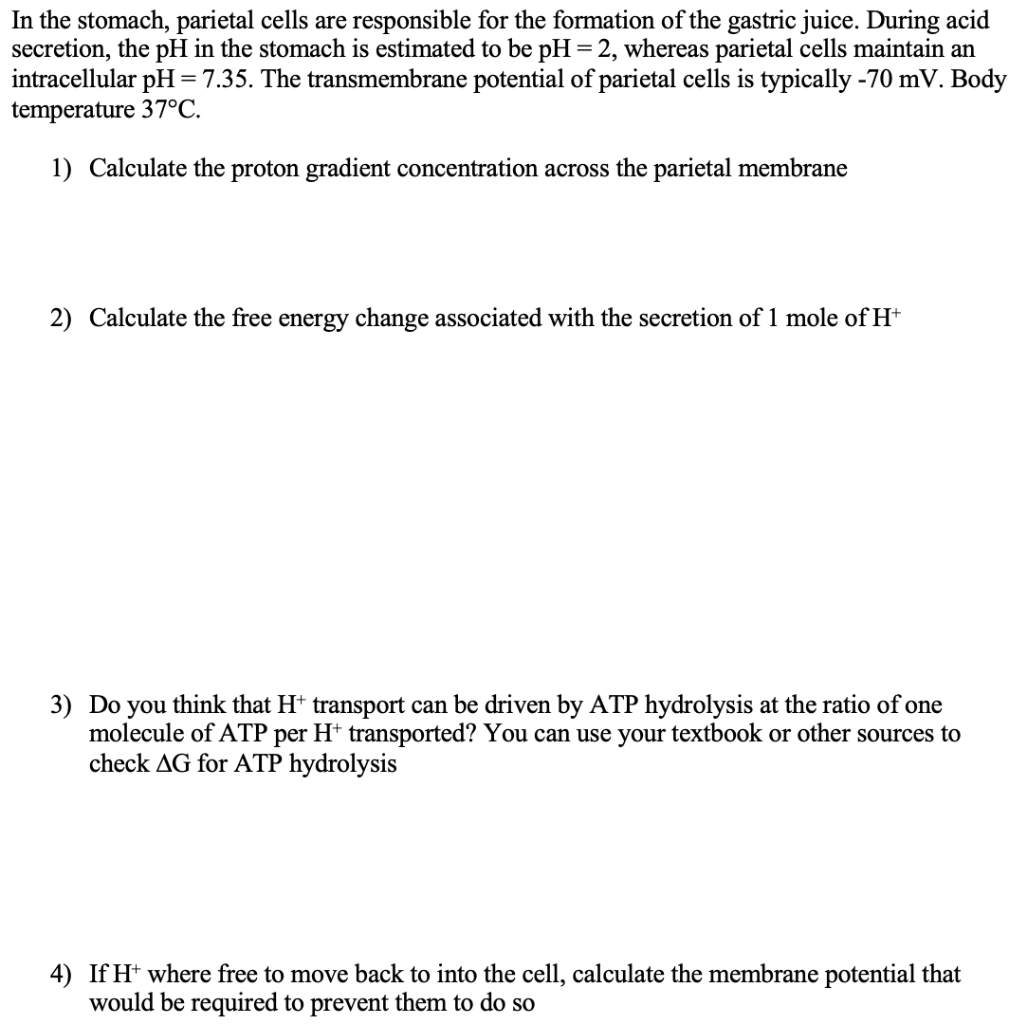In the stomach, parietal cells are responsible for the formation of the gastric juice. During acid secretion, the pH in the stomach is estimated to be pH= 2, whereas parietal cells maintain an intracellular pH = 7.35. The transmembrane potential of parietal cells is typically -70 mV. Body temperature 37°C. 1) Calculate the proton gradient concentration across the parietal membrane 2) Calculate the free energy change associated with the secretion of 1 mole of H*
In the stomach, parietal cells are responsible for the formation of the gastric juice. During acid secretion, the pH in the stomach is estimated to be pH= 2, whereas parietal cells maintain an intracellular pH = 7.35. The transmembrane potential of parietal cells is typically -70 mV. Body temperature 37°C. 1) Calculate the proton gradient concentration across the parietal membrane 2) Calculate the free energy change associated with the secretion of 1 mole of H*
Human Anatomy & Physiology (11th Edition)
11th Edition
ISBN:9780134580999
Author:Elaine N. Marieb, Katja N. Hoehn
Publisher:Elaine N. Marieb, Katja N. Hoehn
Chapter1: The Human Body: An Orientation
Section: Chapter Questions
Problem 1RQ: The correct sequence of levels forming the structural hierarchy is A. (a) organ, organ system,...
Related questions
Question

Transcribed Image Text:In the stomach, parietal cells are responsible for the formation of the gastric juice. During acid
secretion, the pH in the stomach is estimated to be pH = 2, whereas parietal cells maintain an
intracellular pH =7.35. The transmembrane potential of parietal cells is typically -70 mV. Body
temperature 37°C.
1) Calculate the proton gradient concentration across the parietal membrane
2) Calculate the free energy change associated with the secretion of 1 mole of H*
3) Do you think that Ht transport can be driven by ATP hydrolysis at the ratio of one
molecule of ATP per H* transported? You can use your textbook or other sources to
check AG for ATP hydrolysis
4) If H* where free to move back to into the cell, calculate the membrane potential that
would be required to prevent them to do so
Expert Solution
This question has been solved!
Explore an expertly crafted, step-by-step solution for a thorough understanding of key concepts.
This is a popular solution!
Trending now
This is a popular solution!
Step by step
Solved in 3 steps

Recommended textbooks for you

Human Anatomy & Physiology (11th Edition)
Anatomy and Physiology
ISBN:
9780134580999
Author:
Elaine N. Marieb, Katja N. Hoehn
Publisher:
PEARSON

Anatomy & Physiology
Anatomy and Physiology
ISBN:
9781259398629
Author:
McKinley, Michael P., O'loughlin, Valerie Dean, Bidle, Theresa Stouter
Publisher:
Mcgraw Hill Education,

Human Anatomy
Anatomy and Physiology
ISBN:
9780135168059
Author:
Marieb, Elaine Nicpon, Brady, Patricia, Mallatt, Jon
Publisher:
Pearson Education, Inc.,

Human Anatomy & Physiology (11th Edition)
Anatomy and Physiology
ISBN:
9780134580999
Author:
Elaine N. Marieb, Katja N. Hoehn
Publisher:
PEARSON

Anatomy & Physiology
Anatomy and Physiology
ISBN:
9781259398629
Author:
McKinley, Michael P., O'loughlin, Valerie Dean, Bidle, Theresa Stouter
Publisher:
Mcgraw Hill Education,

Human Anatomy
Anatomy and Physiology
ISBN:
9780135168059
Author:
Marieb, Elaine Nicpon, Brady, Patricia, Mallatt, Jon
Publisher:
Pearson Education, Inc.,

Anatomy & Physiology: An Integrative Approach
Anatomy and Physiology
ISBN:
9780078024283
Author:
Michael McKinley Dr., Valerie O'Loughlin, Theresa Bidle
Publisher:
McGraw-Hill Education

Human Anatomy & Physiology (Marieb, Human Anatomy…
Anatomy and Physiology
ISBN:
9780321927040
Author:
Elaine N. Marieb, Katja Hoehn
Publisher:
PEARSON